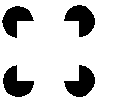About the triangle...


The strange triangle that forms the background of many of our pages may seem odd at first sight. Called a Kanizsa triangle, it is an essential part of the Gestalt theory of perception: a holistic view of how the eye works opposed to a purely reductionist analysis of vision.It may seem self-evident that a triangle is there. But look again... why do you think you see a triangle? There are no lines to indicate a triangle, no explicitly enclosed space to view. Yet the circles marking the corners of the triangle make it readily apparent what we are to perceive. Only by a holistic vision--seeing the three separate "pac-men" as parts of a single whole--do we perceive a triangle.

Another Kanizsa figure.
See this site for an excellent explanation of the various facets of Gestalt, and here for a mathematical, reductionist analysis of vision. These two opposing visions appeared continually throughout the seminar, in discussions ranging from the nature of creativity to the structure of philosophy. We were finally unable to fully reconcile this fundamental dichotomy; its roots perhaps rest in a visceral way of perceiving the world, a mode of vision that can be intellectually explained but never a priori justified.
The triangle--with its intriguing unity of parts and wholes--is a profound metaphor for the nature of our intellectual journey. Like a Gabo sculpture, it is constantly forcing us to rethink the way we perceive our world. It is at once static and dynamic, spinning and centered; an idea that breaks out from the page and draws you into its infinite loops.

Gabo's Column, 1922-23.
A constantly moving kinetic vision, Gabo's sculpture challenges the Gestalt ideal of holistic perception. Each part interacts dynamically with the space around it to create a dizzying sensation of life.
Return to the Architectonic
May 25, 1996.